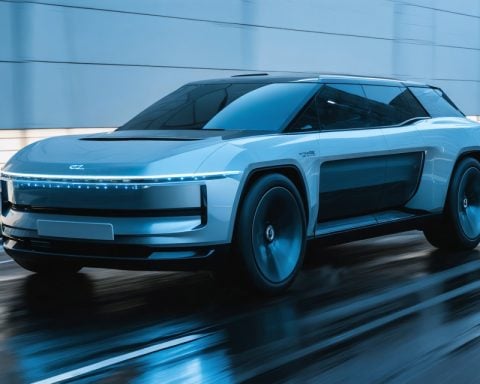- Japan’s UBE Corp. is establishing the first U.S. dimethyl carbonate (DMC) and ethyl methyl carbonate (EMC) plant at Cornerstone Energy Park in Waggaman.
- DMC and EMC are essential chemicals for lithium-ion batteries, crucial for electric vehicles and energy storage.
- Construction, slated for 2025, represents a $500 million investment, creating over 400 construction jobs.
- The plant, expected to be operational by November 2026, will provide 50 to 60 permanent skilled jobs.
- Production goals include 100,000 tons of DMC and 40,000 tons of EMC annually, important for EVs and semiconductors.
- UBE’s U.S. subsidiary, UBE C1 Chemicals America, spearheads this innovative and strategic development.
- This project symbolizes a significant step towards sustainable energy and showcases the fusion of global expertise and local commitment.
Nestled in the heart of Waggaman, a remarkable transformation is set to unfold, one that could redefine America’s footprint in the electric vehicle (EV) industry. Japan’s UBE Corp. is embarking on a venture to establish a revolutionary dimethyl carbonate (DMC) and ethyl methyl carbonate (EMC) plant at the vibrant Cornerstone Energy Park, a first of its kind on U.S. soil. These chemicals are the essential lifeblood for lithium-ion batteries, which power the ever-growing fleet of electric vehicles and storage solutions.
With the construction greenlighted for 2025, this ambitious $500 million endeavor promises to invigorate the local economy, conjuring over 400 construction jobs. Come November 2026, the plant is expected to pulse with activity, creating a robust workforce legacy with 50 to 60 skilled roles.
The new facility, a brainchild of UBE’s U.S. subsidiary, UBE C1 Chemicals America, is poised to churn out a substantial 100,000 tons of DMC annually, providing 40,000 tons of EMC in its wake. These substances are not just pivotal for fueling the electrified roads of tomorrow, but they also play a crucial role in crafting the semiconductors that drive today’s digital world.
This groundbreaking effort in Waggaman is more than just a physical plant; it’s a symbol of innovation and industrial commitment. As the U.S. ramps up the shift towards sustainable energy solutions, UBE Corp.’s venture signals a promising advance along the green, electrified path — a testament to blending global expertise with local resolve.
The Future of EV Battery Innovation: What UBE’s New Plant Means for You
How-To Steps & Life Hacks
Understanding the impact of UBE’s new plant requires considering the broader context of battery technology. Dimethyl carbonate (DMC) and ethyl methyl carbonate (EMC) are vital electrolytes in lithium-ion batteries. To better comprehend their role:
1. Research Battery Basics: Start with lithium-ion battery components to understand the importance of electrolytes like DMC and EMC.
2. Follow Industry Leaders: Keep an eye on updates from companies like UBE Corp., Tesla, and Panasonic, which are at the forefront of battery innovations.
3. Adopt Green Solutions: Integrate energy-efficient practices and products in daily life, supporting the transition towards sustainable energy.
Real-World Use Cases
The establishment of the UBE plant is significant due to its direct impact on several industries:
– Electric Vehicles: It will support the growing demand for EVs by boosting battery production.
– Consumer Electronics: EMC also plays a role in semiconductors that are essential for smartphones and laptops.
– Renewable Energy Storage: The project will facilitate improved energy storage solutions via advanced battery technologies.
Market Forecasts & Industry Trends
According to a report by Allied Market Research, the global lithium-ion battery market is expected to reach $129.3 billion by 2027, growing at a CAGR of 18.0% from 2020 to 2027. This growth is fueled by:
– Increased adoption of electric vehicles and renewable energy solutions.
– Innovations in battery capacity and longevity.
The UBE plant is positioned to capitalize on these trends, reinforcing the U.S. as a key player in the global battery supply chain.
Reviews & Comparisons
UBE Corp. faces competition from giants like LG Chem and Panasonic. Compared to these companies, UBE’s unique strength lies in its focus on electrolytes at a domestic level in the U.S., potentially offering logistical advantages and reduced supply chain risks in a rapidly growing market.
Controversies & Limitations
While promising, the production of DMC and EMC faces challenges:
– Environmental Concerns: Production processes must ensure minimal ecological impact. Comprehensive environmental assessments would be necessary to address local and global sustainability concerns.
– Supply Chain Risks: Global supply chain disruptions could impact material availability, affecting production timelines and costs.
Features, Specs & Pricing
While specific pricing will depend on market variables, UBE’s new plant is designed to produce:
– 100,000 tons of DMC annually
– 40,000 tons of EMC annually
This scalability could result in competitive pricing for manufacturers and producers leveraging these materials.
Security & Sustainability
The plant’s establishment underscores a commitment to:
– Environmental Sustainability: By facilitating cleaner, more efficient battery production, the plant supports broader green initiatives.
– Economic Security: It strengthens U.S. energy independence through domestic production.
Insights & Predictions
Experts predict that the demand for DMC and EMC will only increase, driven by the EV industry’s growth. This facility will be crucial in supplying local and international markets, potentially leading to further expansions and innovations in EV technologies.
Tutorials & Compatibility
For those interested in applying this knowledge practically:
– Explore Open Education Resources: Many online courses offer insights into renewable energy and battery technologies.
– Stay Updated: Follow tech and energy news outlets for the latest developments and compatibility tips in the EV sector.
Pros & Cons Overview
Pros:
– Strengthens the U.S. position in the global EV market.
– Stimulates local economic growth with job creation.
– Supports environmental sustainability efforts.
Cons:
– Potential environmental impact if not managed properly.
– Reliance on stable global supply chains for continual output.
Actionable Recommendations
1. Educate Yourself: Understand the role of battery components to appreciate their impact on everyday technologies.
2. Adopt Early: Consider transitioning to greener technologies like EVs as this industry grows.
3. Stay Engaged: Participate in environmental initiatives that align with sustainable energy practices.
For more information about global technology trends and sustainability initiatives, visit UBE Corp.



















